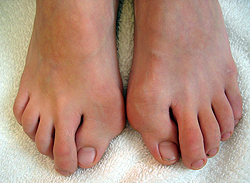With only 1 in 1 million people being affected, Fibrodysplasia Ossificans Progressiva is an ultra rare disease, and the diagnosis relies on a high degree of clinical suspicion and confirmation by genetic testing. Few doctors would encounter it in their education, and the symptoms can be unusual. So unfortunately, it is commonly misdiagnosed.
Development of unusual lumps is often the first presentation of FOP activity, comprising of soft tissue swelling and new bone formation (heterotopic ossification). Heterotopic ossification leads to progressive and permanent loss of mobility. This can occur anywhere throughout the body.

Heterotopic ossification in FOP is exacerbated by soft tissue trauma associated with invasive diagnostic medical procedures, because the lumps may be suspected to be cancer, aggressive juvenile fibromatosis, lymphedema or soft tissue sarcoma. Therefore, catastrophic and irreversible damage can result through the use of intramuscular injections, biopsies and surgeries. Unfortunately this is a common problem for those with FOP. There are critical differences between FOP and these conditions. The key is understanding that there is usually an association with malformed big toes, and the rapidly forming soft tissue swellings that form in characteristic anatomic locations. There are some rare variant forms of FOP that are not associated with malformed toes.
Once the diagnosis is suspected clinically, genetic testing can confirm the diagnosis of FOP, with identification of the mutation in ACVR1. Doctors wishing to arrange genetic testing can contact the international FOP experts listed on our Find a Health Professional page for advice and assistance.
A common misdiagnosis for FOP is aggressive juvenile fibromatosis. This is a benign but highly aggressive condition where connective tissue cells called fibroblasts proliferate in tissue including muscle, tendon, ligament and fascia. These lesions can invade adjacent soft tissue and cause pain and disability, and are often difficult to remove. They often grow slowly and are not associated with the type of swelling seen with FOP lesions, but often the aggressive juvenile fibromatosis lesions do not present until they are fairly large. Thus, many doctors see a soft tissue swelling in a patient with FOP and think it looks like an aggressive juvenile fibromatosis lesion, especially since they arise from similar tissue. If a biopsy is done of very early FOP lesions (fibroproliferative lesions) look like aggressive juvenile fibromatosis under the microscope. However, aggressive juvenile fibromatosis do not progress beyond the connective tissue growth phase, whereas in FOP, they mature through an endochondral process to form cartilage and bone. Once cartilage or bone cells are seen in a lesion, they can no longer be mistaken for aggressive juvenile fibromatosis. However, the critical information to note is that patients with aggressive juvenile fibromatosis do not have malformed toes, and will not have the FOP gene present on testing. Visit our video page to find out more about the Issues and Consequence of FOP Misdiagnosis.
Much remains unknown about the natural history of FOP. Involvement of clinicians and patients in the FOP Registry is vital to help this condition be better understood, and hopefully recognised and diagnosed earlier.
